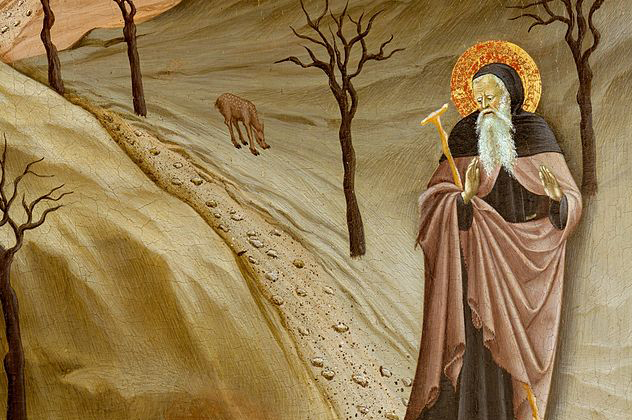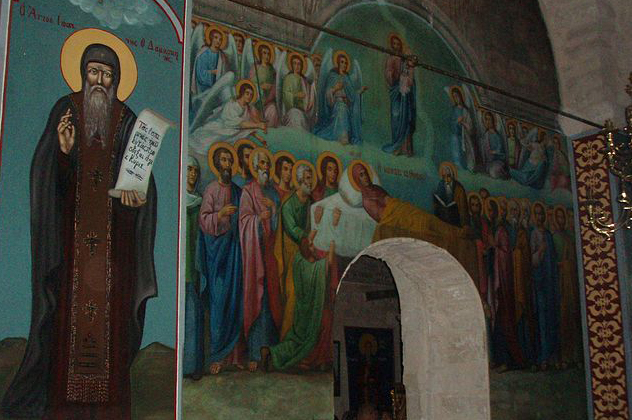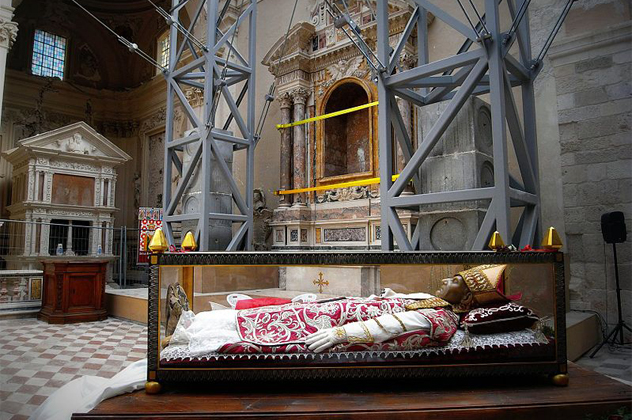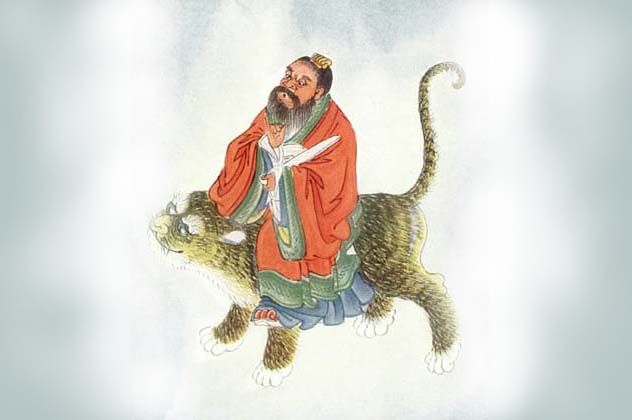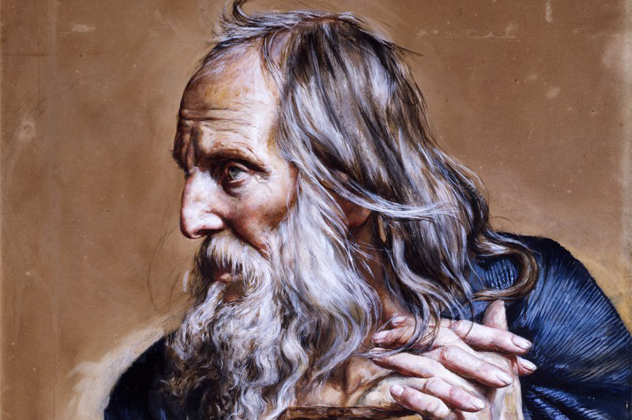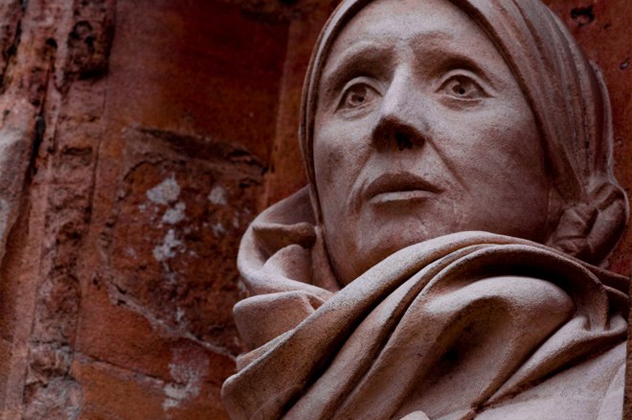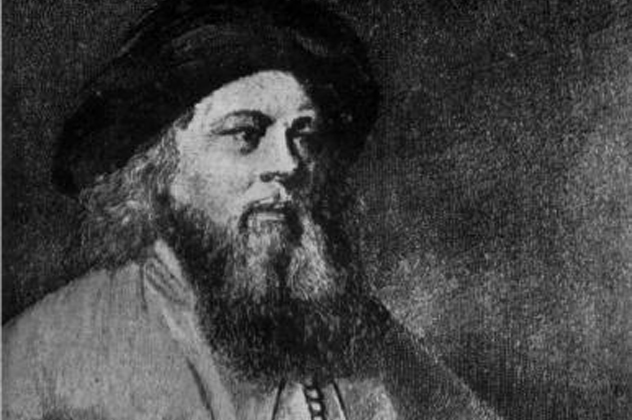10Anthony The GreatA.D. 251–A.D. 356
Born in central Egypt, Anthony was raised by Christian parents and attended church regularly. Described as an obedient and attentive youth, Anthony lost his mother and father when he was only 18. Less than six months after their deaths, he overheard a sermon that changed his life. The man preaching spoke of Jesus saying to sell your belongings to the poor and follow him in order to receive treasure in heaven. Anthony quickly sold everything his parents had left him, entrusted the care of his sister to a household of virgins, and immediately began a life of asceticism. Apart from the normal dangers of living a solitary life in the desert, Anthony was said to have squared off against the devil (as many saints are wont to do), who tempted him with “phantasms of sexual allurements.” He was able to fend off Satan, who appeared to him personally under the guise of a young black boy. Widely regarded as the “father of monks,” Anthony died at the age of 105. Many of his sayings were collected in the book Sayings of the Fathers.
9William ‘Amos’ Wilson1774–1821
William Wilson’s story begins in 18th-century Pennsylvania and involves his sister Elizabeth. She was tricked into having sex with a man named Joseph Deshong, who pretended to have marriage on his mind. In reality, he had no intention of marrying her. When she gave birth to twins, he followed her home and lured Elizabeth and the newborns into the woods, where he murdered the babies and then fled the scene. Elizabeth was convicted of the crime and sentenced to death. William pleaded with the governor to release her, and eventually a pardon was granted. He raced home to save her, but he was too late—she had been hanged moments before he arrived. Discouraged and saddened by his sister’s fate and by the injustice of society (Deshong was never found), William headed back to his birthplace and lived in a cave for the last 19 years of his life, gaining the nickname “The Pennsylvania Hermit.” He supported himself by making millstones, eschewing any other contact with civilization. After his death, his writings were published in a number of different newspapers.
8Gerasimus Of The JordanUnknown–A.D. 475
Although the exact year of his birth is unknown, Gerasimus was born in Lycia in Asia Minor. Born into a relatively wealthy family, he decided to become a monk and headed into the Jordanian desert to live a life of solitude. However, his lifestyle and his ideas attracted followers, and he eventually built a monastery near the Jordan River for them all to stay in. Strict rules of asceticism were followed by the tenants of the monastery, with Gerasimus going so far as to only allow the eating of bread, dates, and water during the week. Cooked food and wine was allowed on the weekend. Perhaps the story for which Gerasimus is best known is that of the lion with a thorn in its paw: A lion limped up to the saint with its paw in the air, clearly in pain. Gerasimus removed a thorn from its paw, and the lion would not leave his side after that. It was given the name “Jordan” and was assigned to be a guardian to the donkey which Gerasimus sent to fetch water. When Gerasimus died, the lion was distraught and lay down on his grave, refusing to move until it died a few days later.
7James Lucas1813–1874
Known as the “Hertfordshire Hermit,” James Lucas was a well-educated doctor with a few minor eccentricities. After his father died, those eccentricities were exacerbated and, after his mother died 19 year later, they became uncontrollable. He moved into his parents’ estate in Hertfordshire and refused to execute their wills, choosing instead to barricade himself inside the house. It quickly fell to ruin, as Lucas chose to only live in the small back kitchen, wearing nothing more than a blanket fastened with a wooden skewer. Though unwilling to mingle with anyone outside of his home, he was more than happy to receive visitors, especially tramps and children. His most famous guest was the author Charles Dickens, who wrote about Lucas in a story called “Tom Tiddler’s Ground” in the literary magazine All The Year Round. Lucas was found by one of his watchmen while having a stroke, and he died a short while after. A large sum of money was found hoarded in his living room.
6Pope Celestine V1210–1296
Dubbed the “hermit pope,” Celestine V was known as Peter of Morrone in his early life. He withdrew from society at an early age, and the strict piety with which he led his life attracted many followers. He later organized them into a group which would come to be known as the Celestines. The pivotal moment in Peter’s life came when he predicted that God would strike down the College of Cardinals, who had gone two years without choosing a successor for Pope Nicholas IV. In the face of the prophecy, the cardinals voted to just go ahead and elect Peter as the new pope. He refused the nomination at first, even going so far as to try to flee. However, the cardinals would not change their minds, and he was soon brought to Naples, where he became Celestine V and was kept on a short leash by King Charles II. Having spent most of his years outside society, Peter knew that he wasn’t up to the job, so he tried to resign and escape into the mountains. Unfortunately, his successor, Pope Boniface VIII, tracked Peter down and stuck him in prison, where he remained until his death.
5Saint Mary Of EgyptA.D. 344–A.D. 421
One of a handful of saints who began their lives entrenched in sin, Mary of Egypt was a prostitute in the city of Alexandria, servicing sailors who came into port. Fleeing to the city at the young age of 12, she refused money for her services, instead supporting herself mainly through begging. She later convinced a group of sailors to take her to the Holy Land. When she got there, Mary tried to enter a church but the Holy Spirit kept her body from crossing the threshold. The sight of an icon of the Virgin Mary caused her to confess her sins and weep. Under the guidance of the voice of the Virgin Mary, she then went into the wilderness across the Jordan River, where she remained alone for 40 years. The future Pope Zosimus was said to have come upon Mary while on his own journey in the desert. She told him her entire story and he gave her communion. Later, after her death, Zosimus was preparing the burial rites when a lion appeared out of nowhere; it dug a grave for Mary with its paws before burying her itself.
4Zhang DaolingA.D. 34–A.D. 156
The legendary founder of the Way of the Celestial Masters sect (otherwise known as the Way of the Five Pecks of Rice), a branch of Taoism, Zhang Daoling lived a relatively nondescript life as a hermit in the mountains of the Sichuan province of China. The nickname for his sect derived from the fact that people paid five pecks of rice every year as a sort of membership fee. Daoling began it after the famed Taoist philosopher Laozi supposedly came to him in a vision, and it became the first organized Taoist church in Chinese history. Giving up his life of solitude to lead his new followers, Daoling preached against what he saw as a lack of respect for truth and goodness in the people of China. The new sect also rejected the traditional sacrifices, which often involved blood and animals, in favor of joss sticks, incense, and boiled vegetables.
3Saint PaulA.D. 228–A.D. 343
Widely considered to be the first Christian hermit, Paul lived during the time of Christian persecution at the hands of the Roman emperor Decius. One such persecution was that of a young male Christian who was tied to a comfortable bed and forced to have sex with a woman. He then bit his tongue off, spat it in the woman’s face, and was martyred. Hearing of these and other persecutions, Paul fled into the desert, where he lived in a cave for anywhere from 60 to 90 years, depending on the source. While in the desert, Paul was fed by a raven who brought him dates and bread. He also encountered Anthony the Great in the wilderness, who had been told in a vision to seek out the elusive hermit. They spoke throughout the night, and Paul told Anthony that he was dying. He asked Anthony to bury him with a special cloak, which was back in the city. When Anthony returned, Paul was dead and his soul was being lifted to heaven by a host of angels. Unfortunately, Anthony had forgotten his shovel, but, similar to the story of Mary of Egypt, two lions showed up and dug a hole with their claws.
2Julian Of Norwich1342–1423
Julian of Norwich is perhaps best known for being the author of the first book written in the English language by a woman, her magnum opus Revelations of Divine Love. She’s now known primarily through that book, and while most of the details are missing, we do know that Julian was already in her cell (a room attached to a church) by the age of 30. It was at the age of 30 that a sickness struck her, one which was so serious that she was given the Last Sacraments. However, she pulled through and the visions she received inspired her to write about the love of God. She often struggled with the evil ravaging the world at the time, and she fought to reconcile that idea with the concept of God’s love. When Julian questioned God and pressed Him for an explanation, He assured her that she need not bother—she would forever remain ignorant of the reasoning. Her year of death, as well as the cause, is a mystery. All that is known is that she was dead by 1423, as her cell was empty.
1Baal Shem Tov1698–1760
Baal Shem Tov, born Israel ben Eliezer and often called Besht, is best known as the father of Hasidism. His life is shrouded in legend and fable, and as such most of the details of his life are a topic of debate. He is said to have been born to parents who were nearly 100 years old. He was orphaned at a young age when they both died of old age. After a relatively nondescript young life in which he worked in various synagogues and schools, Besht went into the Carpathian Mountains, where he lived and meditated on mysticism and spirituality. His reputation as a healer spread far and wide, as did the fact that he conversed with and dressed like “simple people,” something which irked some parts of the Jewish community. Although he never wrote down any of his teachings, they were recorded by his followers and later formed the basis of Hasidism.
+Herman’s Hermits
An English beat group widely popular in the 1960s, Herman’s Hermits formed in 1962 in Manchester. Younger than either the Rolling Stones or the Beatles, they were seen as more appealing to the teens of the day, especially those in the United States. Their most popular songs included “I’m into Something Good,” “Silhouettes,” and “I’m Henry VIII, I Am,” a British music hall song dating back to 1910. The group disbanded in 1971 after years of declining album sales.
